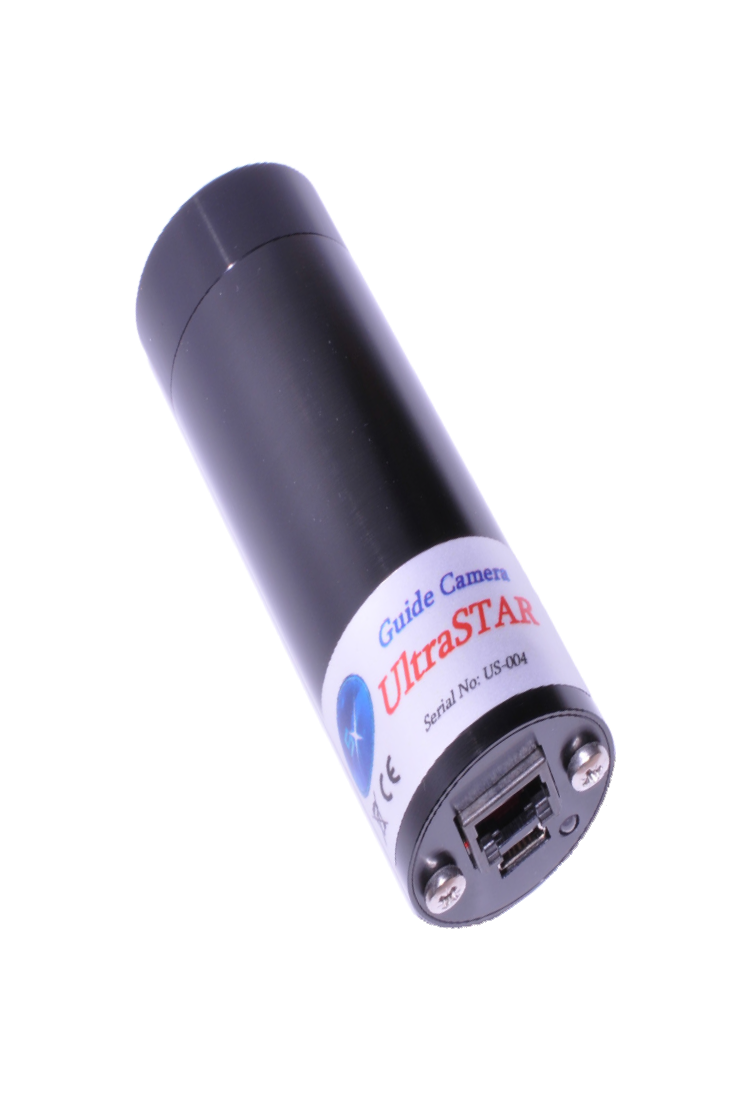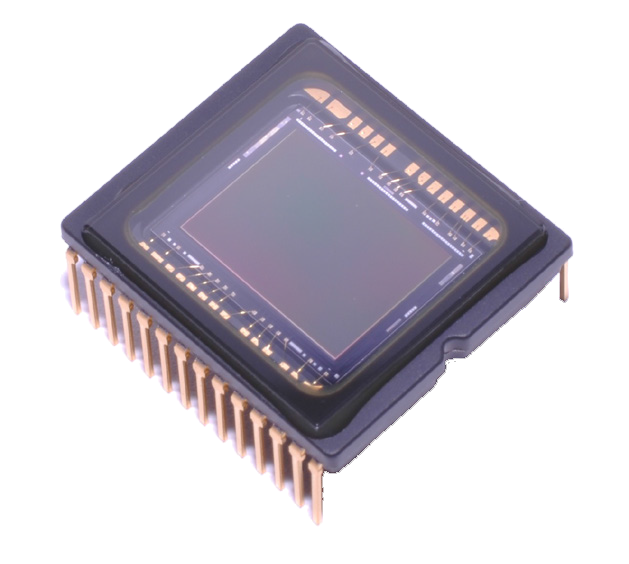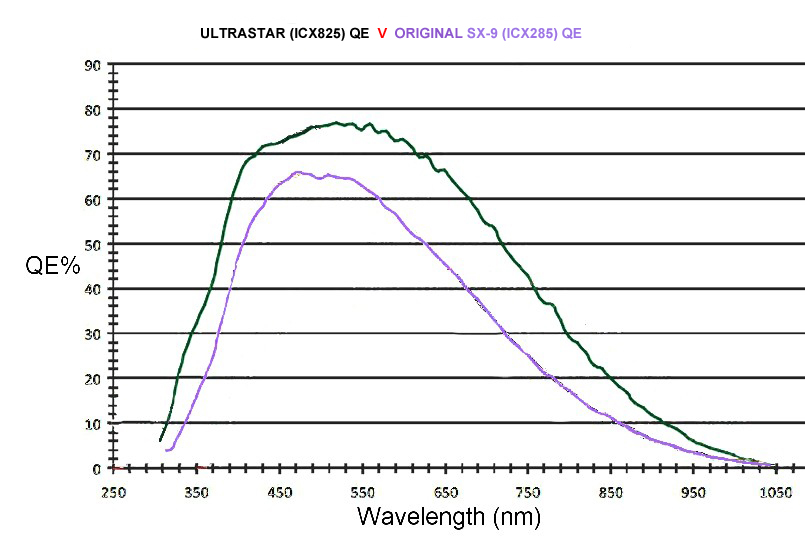|
ULTRASTAR CCD Cameras |
|
....a new form of imaging |
|
|
|
Exceptionally high sensitiviy, incredibly low noise,
miniature, USB2.0 imaging/autoguiding camera |
|
|
Introducing the latest compact imaging/guide
camera from Starlight Xpress.
The Ultrastar is an excellent entry level imaging camera.
When used with the ‘Starlight LIVE’ software, the camera can
be easily configured to take a series or continuous short
exposures, automatically adding the images together as it
goes, building up the image in front of your very eyes.
This concept is perfect for public outreach programs where
the images can be seen ‘developing’ in real time, ensuring
that not only photons are captured, but also their
imagination. Schools and curriculum based astronomy projects
will also benefit greatly from this form of imaging.
The Ultrastar is incredibly compact in size. It is powered
and driven through the mini-USB connection on the rear of
the camera, (<200mA drawn from the USB socket), which makes
it perfect for mobile setups and remote field operation as
well being easily transported. Combine all of these features
with the free ‘Starlight LIVE’ software, Live Viewing
imaging is suddenly amazingly simple and very effective. |
 Conventional
long-exposure imaging is also perfectly practical with the
Ultrastar. The camera is uncooled, but its dark signal is
very low and any warm pixels are easily removed by applying
hot pixel filters, or by stacking ‘dithered’ images.
Conventional dark frame subtraction can also be used. It is
also supplied with original Starlight Xpress imaging
software. Conventional
long-exposure imaging is also perfectly practical with the
Ultrastar. The camera is uncooled, but its dark signal is
very low and any warm pixels are easily removed by applying
hot pixel filters, or by stacking ‘dithered’ images.
Conventional dark frame subtraction can also be used. It is
also supplied with original Starlight Xpress imaging
software.
|
 The
Ultrastar is also a formidable guide camera! The
Ultrastar is also a formidable guide camera!
For years, the Lodestar has been held in the highest regard
as being the best autoguider on the market as well as having
a following of astronomers using it as a Galaxy Imager. The
Ultrastar takes this use to a whole new level with the new
2/3” format ExView II CCD from Sony - now with almost twice
the imaging area and a progressive scan CCD, the Ultrastar
is even better suited for this role.
Key Features:
Big things can come in small packages and
the Ultrastar, really is no exception. This compact guide
camera is packed full of great features:
ONLY 1¼" in diameter allows it to drop neatly into
your 1¼" eyepiece holder - no additional adaptors
required.
Large Imaging Area
(8.98mm x 6.71mm) giving you a wide field of view
for framing galaxies or finding a suitable guide star.
Sensitivity
- with an impressive 75%
QE, and large pixels, the Ultrastar just sucks up those
photons. Sensitivity is key, but combined with the
incredibly low noise of the Ultrastar, images has just
appear even easier.
‘Full size RJ12’ Autoguider
Port - No need to run extra cables from
your computer to control your mount corrections.
Powered by the USB
of your computer so no need to carry an extra
power supply with you - one less thing to forget when
you are on your way to the Star Party.
Compact and solid
aluminium
contruction.
|
 |
The latest EXview HAD CCD II™
from Sony. Super sensitive and in a 2/3” format CCD, giving
you a large area to both image galaxies and planetary
nebular or find a suitable guide star if used as a guide
camera |
 |
Peak sensitivity in the yellow part of the visible spectrum
with a very high 75% Quantum Efficiency. |
 |
The Ultrastar has a full size RJ12 guider socket with ‘ST4’
output via Opto-Isolators (optical relays) with switching
currents up to 50mA. |
 |
Takahashi EM200 Wiring Conversion Diagram. |
|
|
|
|
| ULTRASTAR Specifications |
|
|
| CCD Type : |
IXC825AL Sony Exview
interline CCD with ver y low dark current and
vertical anti-blooming. |
| CCD Full Resolution Pixel
Data : |
Pixel Size: 6.45uM x
6.45uM, Image Format: 1392 x 1040 pixels |
| CCD Image Area : |
8.98mm (Horizontal) x
6.71mm (Vertical) |
| CCD Quality : |
Grade 1 |
| Spectral Response : |
QE Max at 620nM (~75%),
45% at 400nM and 770nM. |
| Readout Noise : |
Typically 5 electrons RMS |
| Full-well Capacity : |
Greater than 23,000 e-
(unbinned) |
| Anti-Blooming : |
Overload margin greater
than 1000x. |
| Dark Current : |
Dark frame saturation
time greater than 1 hour. Less than 0.1
electrons/second @ + 10C ambient. |
| Data Format : |
16 bits |
| System Gain : |
0.3 e/ADU |
| Computer Interface : |
Built-in USB 2.0
compatible interface. |
| Image Download Time : |
2 frames per second (in
full resolution). |
| Power Requirements : |
USB powered. |
| Cooling System : |
Ambient air cooling. |
| Size : |
31.75 x 85mm black
anodised aluminium barrel with 1" x 32tpi 'C Mount'
thread at the CCD window end & input/output plugs at
rear. |
| Weight : |
approx. 85g. |
|
|
|
|
|
|
|
|
Click Here to return to the
main STARLIGHT XPRESS page |
|
|